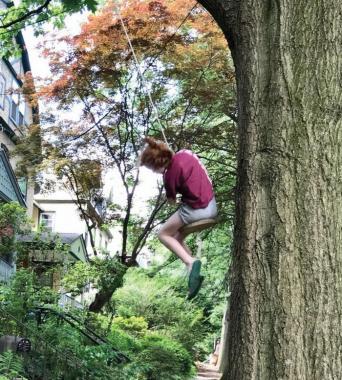
Liberate Your Lawn & Garden: Ah, the Benefits of Trees — And Tree Swings, Too
“One generation plants the trees, the next gets the shade.”
— Chinese proverb on a bumper sticker hanging in my office
It’s dusk, 85 degrees and I have a thought while sitting on my front porch listening to my son and daughter’s laughter as they swing enthusiastically out over the sidewalk: What if every home in Philadelphia had a swing suspended from a tree like this? Can we even imagine the opportunities?
Our swing hangs from a tall, beautiful Red Oak (Quercus rubra) that has stood vigil at the front of our house for at least 50 years. It’s one of more than two dozen large street trees in our neighborhood, and I have always been grateful for the shade and respite it provides on hot days, as well as the privacy it affords our second-and third-story bedrooms and the protection it offers beyond our home to our local Wissahickon Watershed.
If you enjoy reading about nature as I do, there are volumes written on the benefits of trees: improved health and well-being; lower temperatures; improved air quality and carbon sequestration; stormwater mitigation; clean water; and soil protection, to name a few. These are all ecosystem services — local ecology providing necessary utility for us, naturally and free of charge!
According to the EPA’s website on heat island effect, tree-shaded surfaces may be 20-45 degrees cooler than unshaded and can reduce peak summer temperatures by 2-9 degrees. This offers considerable savings to homeowners — we only just turned on our air conditioning this week — and our municipalities.
And then there’s biodiversity. According to Doug Tallamy, entomologist and author of “Bringing Nature Home,” our majestic Oak supports some 534 species of Lepidoptera (butterfly, moth and skipper insect families) and is a huge source of food for small mammals, including the growing squirrel family in our backyard. In a nutshell, it’s a source of sustenance, nourishment and life.
I grew up in Connecticut, on more than 10 acres in the rural outskirts of New Haven County. We had a tire swing, wooden swing, treehouse, numerous forts in the woods (my favorite under a grove of Eastern Hemlock [Tsuga canadensis]), a pond with box turtles and bull frogs, a meadow filled with fireflies, and an apple orchard. To say I was blessed is an understatement, as I spent more time up in a tree, and outside than in. It was only after moving to Philly that I recognized and acknowledged the privilege it was. For this reason, you could say I have a love-hate relationship with our fair city — urban yards, sparse vegetation, limited community park space and lots of hot, paved spaces. “Unbearable” is a word that easily comes to mind.
In July’s heat, in the middle of a global pandemic with family home, I am reminded daily of the stark contrast between my childhood and that of my kids and others in Philadelphia. With limited camp and vacation options right now, everyone needs a little nature. So, what if every family in every neighborhood had a large native tree that provided much welcome shade, seasonal intrigue, habitat for birds and butterflies, increased health benefits, and, of course, a swing? A different landscape? Yes! An opportunity? Absolutely! Valuable? Priceless!

